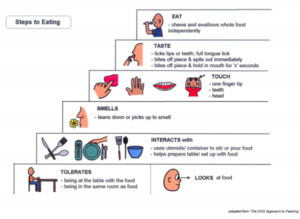Why are some kids “fussy eaters”?
Food is a huge part of life and daily routines and can be incredibly enjoyable. However, for many children (and parents!) mealtimes and eating can be one of the most stressful parts of their day.
In the DWSP clinic we work with families and children who have limited preferences, e.g. may only eat a handful of different foods, or who dislike different textures, colours, and or tastes, difficulty with chewing and swallowing, children who take a long time to complete meals, e.g. avoid meals or have difficulty using cutlery/hands, or children who may find it hard to physically sit and focus for mealtimes.
There are so many reasons why a child might have some of these difficulties. ‘Fussy eating’, restricted food preferences or challenging mealtimes can be due to a number of reasons including (but not limited to); poor oral-motor/swallow skills, pain/discomfort, sensory processing difficulties, learning, behavioral or nutritional factors.
Because there are so many factors involved in feeding and eating, it is important to have a team approach. Clinicians work alongside parents and caregivers to develop a plan to support food management at home and to take (and celebrate!) small steps toward achieving goals.
So much is involved in eating!
Eating is one of the most complex tasks we do and involves multiple body systems. It’s a multi-sensory process, meaning there is much more to it than simply chewing and swallowing (see diagram).

The SOS (Sequential Oral Sensory) Approach to Feeding is commonly used by our therapists to support families with problematic feeding and looks at the ‘whole child’. For some children, even having certain foods on the table can be overwhelming! This approach starts with just being in the same space as food, and looking at it. Although this sounds simple, even this first step can be really challenging for some kids.
Ideas to support eating at home:
Having ideas to use at home in the natural environment is really important in order to see success. If you feel that mealtimes are becoming a battle in your home, here are some simple strategies that you can try:
- Posture: We need to make sure our body is first ready for eating. Have your child’s feet on the floor or footstool and use a chair with arm and back rests.
- Routine: create a routine for snacks and meals.
- Get messy: explore the different properties of food through food play in a fun and comfortable environment. Crunchand squish food, talk about how it sounds, smells, tastes and don’t be scared to get messy and have fun with food. It’s not always about eating it.
- Involve kids in the whole process: hold and talk about food at the supermarket, touch and compare different produce at a farmers market, or grow your own food. Get your child to help with mixing and preparing food at home.
Chatting further with an Occupational Therapist or Speech Pathologist will help you to develop strategies specific to your child and family goals.
*Diagram and strategies adapted from SOS Approach to Feeding framework developed by Dr Kay Toomey and colleagues.

